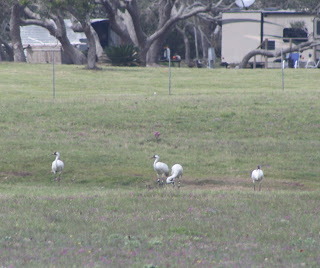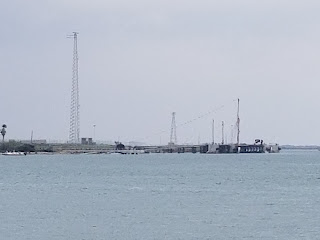The wind here has been steady and fast. It usually starts at
about eleven miles and hour and quickly increases to twenty plus. At these speeds
kayaking is out, for us anyway, and even those with boats have been staying
put. So, when Renita’s sister Pam, mentioned that she wanted to go to Lamar and
look at the whooping cranes, we all agreed!
Its only a few miles across the Copano Bridge and taking the
first turn into Lamar takes you past the State Park entrance before connecting
you with St Charles Bay. A little further, just past the heavily damaged Duck
Hunting club, and you reach a field in which you can often see the whoopers. We
were lucky as four whoopers were feeding!
We watched for awhile before heading over to Big Tree, the
biggest and oldest live oak in Texas. It survived Hurricane Harvey even though
many of the other oaks were uprooted and destroyed. You can see the massive
root structure. The tree is thirty-five feet in circumference!
As walked around the tree, spring flowers were in bloom. One
of the many joys here in Texas is the amazing plethora of wild spring flowers.
To us the only thing to compare it to is the mountain meadow bloom that takes place
high in The Rockies.
Returning to the truck we drove to the opposite side of the
meadow. The landowners were digging out Canadian thistles, a hated invasive
species that also plagues us in Wyoming, and nearing the pond caused the
whooping cranes and rosette spoonbills to take flight.
The rosys quickly landed at another spot on the pond, while
the whoopers went to another close by meadow,
(if you look closely you can see that the two adult whoopers are carrying accessories, i.e. radio transmitters on the legs).
(if you look closely you can see that the two adult whoopers are carrying accessories, i.e. radio transmitters on the legs).
The whoopers should be heading north to their breeding grounds
in Canada. We did see a large flock of black bellied whistling ducks but did
not see any sand hill cranes. The sand hills might have already left. We do have
a large sand hill population near us in Star Valley, Wyoming. Perhaps some of
the ones we see here travel the same path, only in the air.
Our own migration starts Sunday when we plan on attending Easter
service before heading out to Matagorda. We wish you all safe travels and of
course clear skies.









































